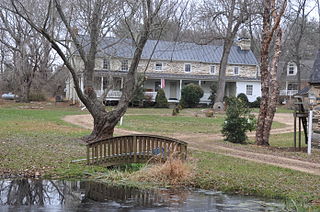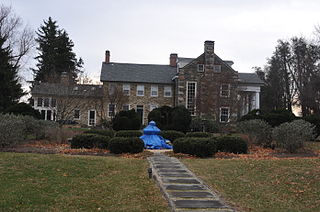
Nolands Ferry I Archeological Site is an archaeological site near the historic Noland's Ferry boat landing at mile 44.58 on the C&O Canal and Tuscarora. The Archeological Site is a prehistoric occupation site located in the Monocacy region of southern Frederick County, Maryland. Diagnostic artifacts at the site indicate that the site was almost continuously inhabited from the Paleo-Indian period to the early 19th century, with the most substantial inhabitation occurring during the Late Woodland period.
Chestnut Hill is an 18th-century Federal-style mansion north of Leesburg in Loudoun County, Virginia, United States. Chestnut Hill was a home of Thomson Francis Mason, a prominent jurist, lawyer, councilman, judge, mayor of Alexandria, and grandson of Founding Father of the United States George Mason. Chestnut Hill was also a home of Mason's son, Dr. John "Frank" Francis Mason. It is located at 13263 Chestnut Hill Lane near Leesburg.

The Glebe of Shelburne Parish is a house built as a glebe in rural Loudoun County, Virginia around 1775 to attract a cleric to preach in the Shelburne Parish of the Anglican Church. Shelburne Parish, named for the Earls of Shelburne, desired in 1771 that a minister preach at Leesburg, Virginia every three months. The absence of a glebe and glebe lands detracted from efforts to recruit a parson, so in 1773 the parish purchased 473 acres (191 ha) and built a house on the property.

Janney House, also known as Morrison House and Janney Hill, is a historic home located at Hamilton, Loudoun County, Virginia. It was built in 1876, and is a 2+1⁄2-story, five bay, wood frame I-house in the Late Victorian style. It sits on a stone foundation and has a standing seam metal side gable roof. It features a one-story, wraparound porch. Also on the property is a contributing combination garage and stable building.

William Smith House, also known as Jonas Smith House and Boidock House, is a historic home located at Hamilton, Loudoun County, Virginia. It was built about 1813–1820, and is a two-story, three-bay, Federal style brick dwelling. It has a recessed right-side dining and kitchen wing, also in brick, originally 1+1⁄2 stories, now two stories. Also on the property are the contributing brick barn with diamond-patterned ventilation holes, two-story springhouse, a wide loafing shed, a large corncrib, and two-car garage.

Myrtle Hall Farm, also known as Meadow Farm, is a historic plantation house and farm located near Bluemont, Loudoun County, Virginia. The original section of the house was built about 1813, and consists of a two-story, brick main block with a smaller two-story service wing and single story kitchen addition. A two-story library addition was built in about 1850. The house is in the Federal style. Also on the property are the contributing stone springhouse (c.1813), The Mordecai Throckmorton Family Cemetery, wood shed, stone-lined well, tenant house (1949), two-story guest house, tennis court, and stone entry.

Cleremont Farm is a historic home and farm located near Upperville, Loudoun County, Virginia. The original section of the house was built in two stages between about 1820 and 1835, and added onto subsequently in the 1870s. 1940s. and 1980s. It consists of a stone portion, a log portion, and a stone kitchen wing. It has a five bay, two-story, gable-roofed center section in the Federal style. A one-bay, one-story Colonial Revival-style pedimented entrance portico was built in the early 1940s. Also on the property are the contributing original 1+1⁄2-story, stuccoed stone dwelling (1761); a stone kitchen from the late 19th or early 20th century; a stuccoed frame tenant house built about 1940; a stone carriage mount; and a series of five stone walls.

Rich Bottom Farm is a historic home located near Purcellville, Loudoun County, Virginia. The house was built in three sections between about 1780 and 1820. It is a two-story, limestone and brick structure with a side gable roof in the Federal style. The front facade features an eight bay, full-width frame porch. Also on the property are the contributing two-story limestone spring house and limestone smokehouse.

Edward Nichols House, also known as Hillcrest, is a historic home located at Leesburg, Loudoun County, Virginia. It was built in 1899, and is a 2+1⁄2-story, irregularly shaped, beige brick dwelling with Queen Anne and Colonial Revival style decorative details. It has a tall hipped roof, two-story rear ell, and features projecting two-story bay windows topped with gables on the front and east elevations. Also on the property are the contributing laundry, carriage house / barn with attached water tower, and storage shed.

Sleepy Hollow Farm is a historic home located near Leesburg, Loudoun County, Virginia. The house was built in two phases, one in 1769 and another about 1820. The original section is a two-story, side-gable, three-bay, stone dwelling with a side gable roof. The interior exhibits stylistic influences of the Federal style. Attached to it is a one-story, two-bay, stone addition built about 1820. It has a one-story section added about 1980. Also on the property is a contributing stone spring house.

Home Farm is a historic home located near Leesburg, Loudoun County, Virginia. The original log section of the house was built about 1757, with a stone addition built about 1810, a frame addition built about 1830, and a frame kitchen addition built about 1930. It is an "L"-shaped, two-story, single-pile vernacular house clad in wood siding, random rubble fieldstone, and brick veneer laid. The interior exhibits stylistic influences of the Federal style. Also on the property are a contributing early-20th century henhouse, the stone foundation of a spring house, and a dry-laid fieldstone wall.

Rock Spring Farm is a historic home located at Leesburg, Loudoun County, Virginia. The original section of the house was built about 1826, with wing and one-story addition built about 1906, and hyphen in 1980 to connect to the original brick kitchen. It consists of a 2+1⁄2-story, four-bay, brick main block in the Federal style with a two-story rear ell and flanking wings. The house was updated near the turn of the 20th century with Colonial Revival style details. Also on the property are a contributing spring house, smokehouse, barn, dairy, silo, tractor shed, and stable.

Woodgrove is a historic home located near Round Hill, Loudoun County, Virginia. The original section of the house was built around 1785, with a rear ell added around 1840, and an addition with a new main entrance in about 1910. All sections are two-and-a-half stories in height and constructed of native fieldstone. The oldest section of the house is in the Federal style and the 1910 addition is in the Classical Revival style. Also on the property is a contributing fieldstone meat house, built around 1840.

Crednal is a historic home located near Unison, Loudoun County, Virginia, United States. The building is an example of an early-19th-century, Federal-style, two-story, five bay, brick dwelling built in 1814, that was constructed around an existing 18th-century, vernacular, residential stone core. A two-story, three-bay frame wing was constructed in 1870. In 1993, a two-story, two-bay, Greek Revival-style brick dwelling that had been slated for demolition from Greene County, Virginia, was moved to the property and attached to the house by a hyphen. Also on the property are the contributing Carter family cemetery and an unmarked slave cemetery.

William Virts House, also known as the Uriah Beans House, is a historic home located near Waterford, Loudoun County, Virginia. It is a 2+1⁄2-story, three-bay, Federal-style stone dwelling that took this form about 1813. It has a side gable roof and sits on a banked basement built about 1798. Also on the property are the contributing 1+1⁄2-story vernacular stone spring house built about 1813 and frame shed built about 1840.

Ben Lomond, also known as Ben Lomond Plantation, is a historic plantation house located at Bull Run, Prince William County, Virginia. It was built in 1837, and is a two-story, five bay, red sandstone dwelling with a gable roof. The house has a central-hall plan and one-story frame kitchen addition. One-story pedimented porches shelter the main (north) and rear (south) entries. Also on the property are the contributing frame two-story tenant's house, brick pumphouse, and a bunkhouse dated to the early 20th century; and a meat house, dairy, and slave quarters dated to the late-1830s.
Willson House, also known as Tuckaway and Wee Dornoch, is a historic home located near Lexington, Rockbridge County, Virginia. It was built in 1812, and is a two-story, five-bay, Georgian / Federal style brick dwelling, with a one-story kitchen wing. It has a side gable roof, interior end chimneys, and a central-passage plan. The front facade features a pedimented entry porch with brown sandstone front steps. Also on the property are a contributing smokehouse and garage.

Brown's Ferry, also known as the Mahone House, is a historic home near Courtland, Southampton County, Virginia. It was built about 1815, and is a large two-story, five-bay, Federal style brick dwelling. It has a one-story kitchen attached to the rear. The main house has a side gable roof and three interior end chimneys. The interior features notable woodwork and painting. Also on the property are a contributing smokehouse, corn crib, and pole barn. It was the birthplace of Confederate General William Mahone (1826–1895).

The Oakham Farm is a historic farm at 23226 Oakham Farm Lane, near Middleburg in Loudoun County, Virginia. The farm includes 100 acres (40 ha) of land north of United States Route 50, with its building complex anchored by a farmhouse built in 1847 and repeatedly altered. The main portion of the farmhouse is a 1920s three-story Classical Revival block, which has the original 1847 two-story Greek Revival house attached as an ell to one side, along with another c. 1840 structure that may have functioned as a separate kitchen. The property was first developed by the Peyton family, with its present buildings dating to the ownership of the Rogers family. During the American Civil War, Oakham was where the irregular Confederate Army unit known as Mosby's Rangers was organized.
Josiah Clapham was a colonial merchant, military officer, and politician in Virginia who served as a member of the House of Burgesses and later the Virginia General Assembly, representing Loudoun County.






















